Pictures of All Fireflies That Are Blue and Red Pictures of All Fireflies That Are Colored
TYPES OF FIREFLIES
Scientifically, fireflies are classified under Lampyridae, a family
of insects within the beetle order Coleoptera, or winged beetles.
While most fireflies are characterized by their use of bioluminescence
to attract mates and communicate with others in their species, not all
insects within the firefly family produce light. Some communicate using
pheromones, a sort of insect perfume.
There are thousands of firefly species spread across temperate and tropical
zones all over the world. In New England alone, you might see twenty or
thirty species. But all fireflies are classified under five main subfamilies.
Lampyridinae (subfamily)
Photinini
If you live in North America, these are the fireflies you're probably
most familiar with. Not all fireflies in this subfamily light up, but
those that do are generally divided into many closely related species.
Photinus fireflies tend to be the most common
of this group; about half an inch long, these produce yellow-green light. The
most common amoung this group is Photinus pyralis, or the common eastern firefly.
This is most likely what most people will see in their backyards at night. Below
is a picture of Photinus pyralis, the most common firefly species you will see at night.
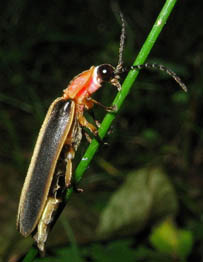
Photinus carolinus is the synchronous firefly species that produces the beautiful synchorized displays
in the Appalachian mountains of the US. They occur in 4 US states with Elkmont, Tennessee having the largest populations.
They are 8-12.5mm long, and produce a yellow-green synchronized flash
in order to signal to females. These fireflies are found in hardwood forests near creeks or rivers.
They can be seen in the third week of May to the third week in June starting at 9:30pm eastern time in the US.

Cratomorphini
Pyractomena fireflies produce a yellow-amber
flicker that looks a bit like a spark from a campfire.
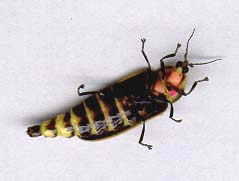
Phausis
Phausis reticulata also known as blue ghost fireflies.
These tiny fireflies are common throughout the southeastern US and are
known as the "blue ghost" because they do not flash but glow with an eerie
blue or green light. Females of the blue ghost are pale yellow or white
in color and lack wings (right in photo below). Males do have wings and
can fly (left in photo below). Since they have not be studied extensively
little is still known about them and their habits.
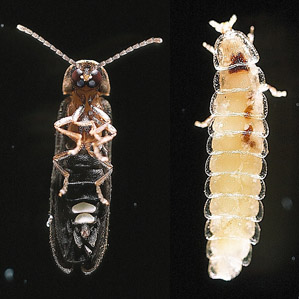
Pleotomini
Pleotomus fireflies are relatively uncommon. Both Pleotomus
pallens and Pleotomus nigricans occur in the southwest. Scientists are still discussing whether
they should be classified as one species or two distinct species. They are also found in Mexico.
Pleotomus davisii is found in Tennessee and Kentucky rarely.
The following is an example of Pleotomus sp. larvae. At this stage the larvae glow periodically
throughout the night. They are found after dark crawling along the ground in the leaf litter
looking for things to eat. The most common time to find them is after a big rain storm preceding
a dry period. These particular larvae were found on the river bottom of the Devil's river in Texas during May 2015.
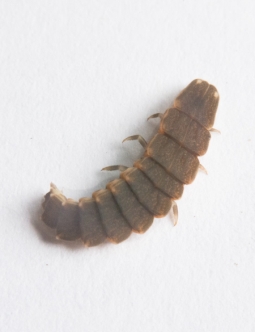
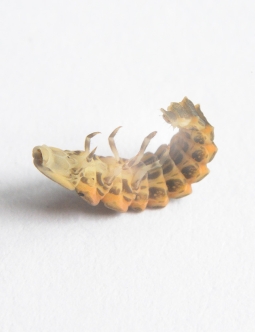
Lampyrini
Microphotus is a small genus of nocturnal glowworm fireflies occurring
throughout the southwestern United States and adjacent parts of Mexico. They are found in
discontinuous pinyon-juniper and juniper-oak habitats.
Females have no wings and are larva-like in appearance. Both males and females possess paired photic
organs on the terminal abdominal sections. Females emit intermittent glows to attract
males. Males, while capable of emitting weak glows or flickers, apparently do not use
bioluminescence in sexual communication.
Lamprocerini
Tenaspis belongs to a much larger neotropical fauna of fireflies. There is only one species, Tenaspis angularis (Gorham), in the US.
These fireflies are primarily found in the Gulf states of the US. Nothing is known about the larval form of this genus.
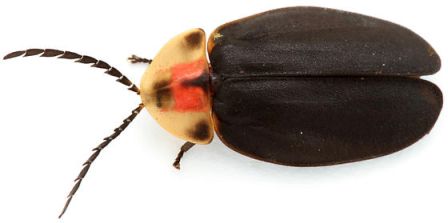
Photurinae (subfamily)
Photurinae
Photuris fireflies are larger—almost an inch
long—and produce a darker green light. They're very difficult to distinguish
from Photinus from their light alone, even for other fireflies; female
Photuris often mimic mating flashes from female Photinus fireflies to
attract and eat Photinus males. Because of this, Photuris species are
sometimes called "femme fatale" fireflies.
Photuris versicolor is a part of a species complex of 17 named species, with an additional 30 or more yet to be named by Jim Lloyd (L. Faust personal communication). Photuris versicolor occurs from the NE of the US, Texas, Utah, Colorado, California, and into parts of Mexico. They are large fireflies, typically 10-15 mm, with females 15-18 mm. They are early season fireflies occuring in late May to late June. There is a predominant diagonal strip on the shoulder of each wing cover. This is one of the predatory fireflies or agressive mimics of other fireflies flash patterns. Females are predatory while males are not. Females are erratic, highly variable flashers, capable of many types of flashes.
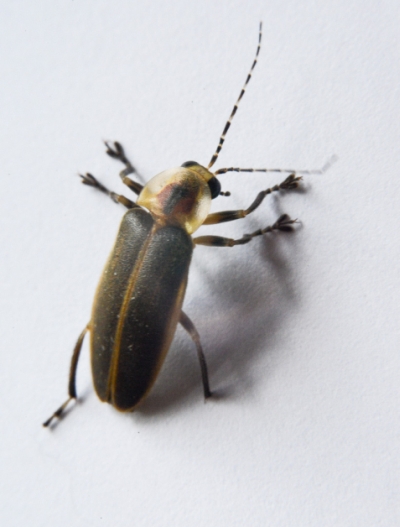
Photuris frontalis is part of a species complex that includes Photuris congener. They are a forest firefly. These are smaller fireflies between 9-11mm. They occur across the southern US into Texas. They have a unique flash pattern that varies based on location, habitat, and temperature. They are recognized as the only synchronous firefly of the North American genus Photuris.
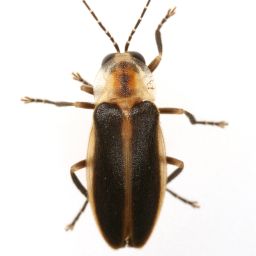
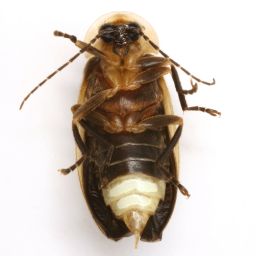
Luciolinae (subfamily)
Luciolinae
This is the largest subfamily of fireflies, with member species scattered
throughout Eurasia, Europe, East Asia, and Australia. The fireflies within
this subfamily all produce light—and flash rather than emit a continuous
glow. Here are a few genera of note within this group.
Peroptyx. Species within this group are mainly
found in tropical Asia. Groups of fireflies will synchronize their flashes
until thousands are all flashing to the same rhythm, producing a stunning
display.
Luciola. These fireflies are sometimes known
as "Japanese fireflies," although they're also found in Asia and more
rarely in southern Europe and Africa. In Japanese traditional culture,
they are believed to represent the souls of the dead.
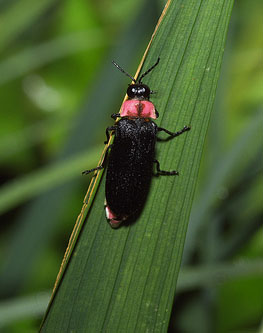
Luciola lusitanica Also known as the Portuguese firefly.
Males of this species are the only ones that fly, females do not fly. Females are usually
found on the ground or in vegetation, they are also bigger than the males. While males flash,
females emit a long or continuous yet unsteady yellow glow from one light organ in it's abdomen.
One advantage that non-flying female fireflies have is they are often able to lay more eggs than flying
females. More energy that normally would be used for flying can be reserved and put towards laying more eggs.
This enables a better chance of survival for more of their offspring.
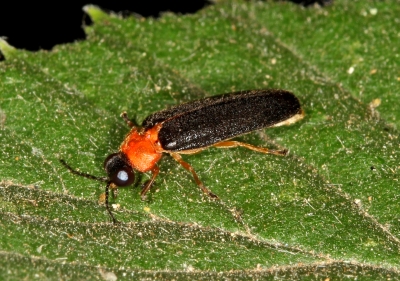
Cyphonocerinae
Cyphonocerinae
Pollaclasis This subfamily of fireflies includes two genera that live in North America
and Eurasia. They're notable because scientists believe they are the most
primitive species of fireflies in existence. One genus within this group
displays very weak light, while the other does not light up at all. The following is male Pollaclasis bifaria, found in Mississippi.
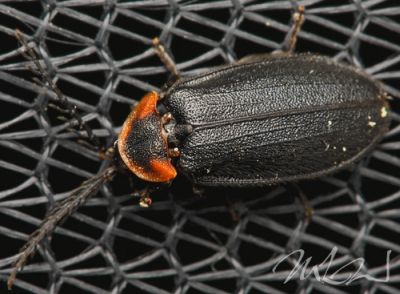
Ototetrinae (subfamily)
Ototetrinae
Scientists haven't decided whether this group should be classified as
fireflies; while they share many characteristics of other species, members
of the group Ototetrinae don't emit light. They're considered very primitive
forms of fireflies, and live primarily in Eurasia and North America.
Lampyris (Genus)
Lampyris
Sometimes referred to by taxonomists as a "catch-all" subfamily classifying
fireflies that don't quite fit into other groups, the species in this
genus live generally in more temperate northern regions of the world. The group contains both flashing
and continuous-glow fireflies. Some larvae species within this group climb
trees to feed on snails and bugs.
Lampyris is a genus of firefly within this subfamily
found primarily in Britain, and they thrive in old-growth grasslands in
soil with high concentrations of limestone and chalk. Only the males fly;
the females are larviform, and only they glow. Females crawl onto blades
of grass and low vegetation at dusk and emit a yellow-green continuous
light to attract mates. Their vernacular name is "glow worm."
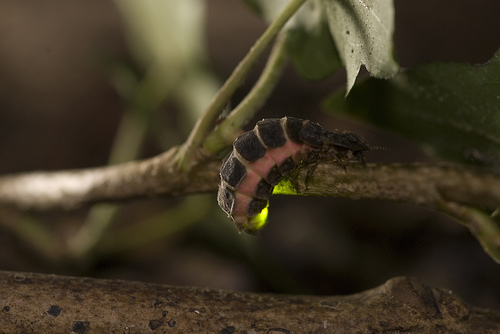
Source: https://www.firefly.org/types-of-fireflies.html
0 Response to "Pictures of All Fireflies That Are Blue and Red Pictures of All Fireflies That Are Colored"
Post a Comment